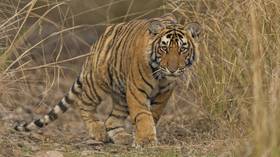On the catwalk: Primal desire for food and a friend sends Indian tiger on record 1,300km trek

A young Indian tiger has traveled 1,300km (over 807 miles) in just 150 days, seeking new game-rich territory... and romance. The big cat’s impressive journey has become the longest tiger walk ever recorded in India.
The tiger, from Tipeshwar Wildlife Sanctuary, had a radio collar attached in March, as part of a long-term study into the migration and dispersal of the large cats. It left the reserve in June to undertake what turned out to be an epic journey.
After months of walking, the tiger eventually reached another reserve – Dnyanganga Wildlife Sanctuary – last weekend.
R Govekar, Field Director, Pench #Tiger Reserve: A radio-collared tiger of Tipeshwar Sanctuary in Yavatmal (Maharashtra), reached Dnyanganga Sanctuary in Buldana district yesterday, after travelling over 1300 km distance in about 5 months. He left Tipeshwar Sanctuary in June 2019 pic.twitter.com/hEzAxx4SOG
— First India (@thefirstindia) 2 декабря 2019 г.
While most of its journey spanned wooded areas, the animal also traveled through densely-populated open landscapes. The young tiger, however, largely managed to avoid interactions with humans during its voyage, traveling at night and resting during daylight, while preying on wild animals and cattle for food. Only one incident was recorded en route: the tiger injured a man after a group of villagers strayed into a grove where the beast was taking a nap in Hingoli district.
The tiger was likely driven to set out on its journey by a desire to find mates and more plentiful food, researchers believe. The distance it traveled exceeded all previous estimates and might become a turning point in understanding the big cats’ migration techniques.
“It indicates that the tigers may have to cover much longer distances and cross the human-dominated, non-forested landscapes in the pursuit of its new territory and mates, much beyond our traditional understanding,” Field Director of Pench Tiger Reserve Dr. Govekar Ravikiran said, as cited by local media.
Also on rt.com VIDEO of Indian bikers nearly becoming tiger’s lunch goes viralWhile the animal has succeeded in reaching a base with good prey, it remains unclear whether it managed to find any mates during the hike.
Think your friends would be interested? Share this story!














